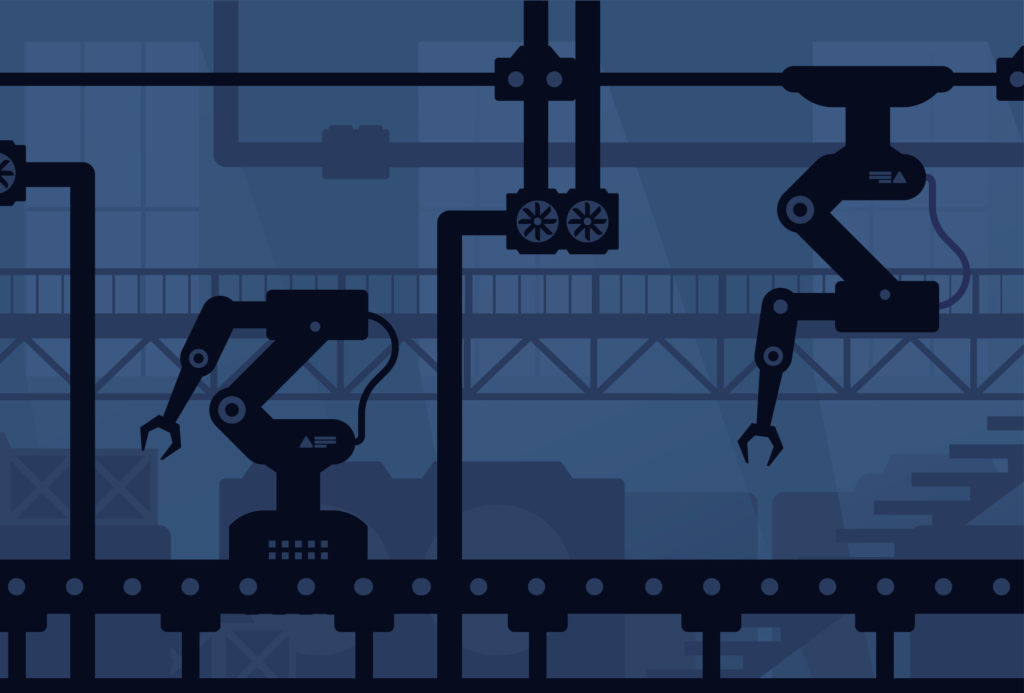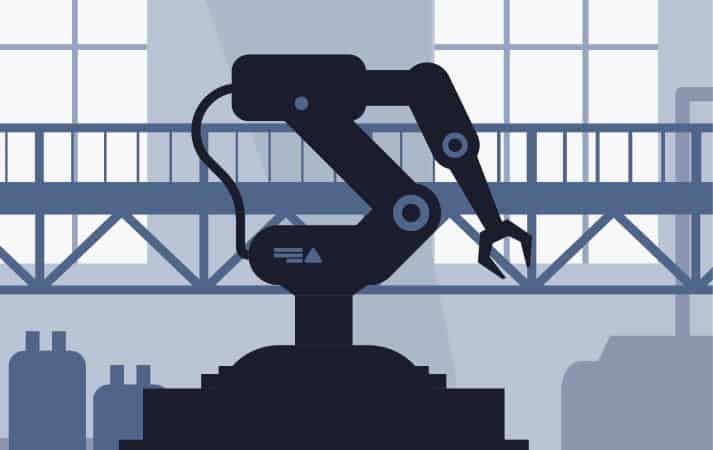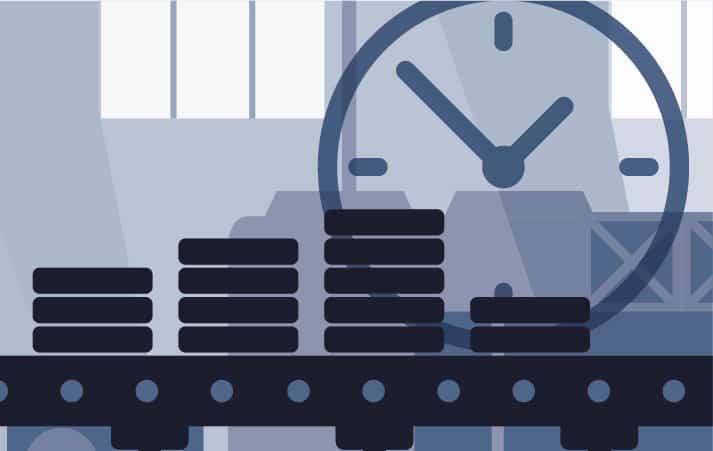
Manufacturing in the U.S. has contracted to its lowest level in more than a decade. The Institute for Supply Management said that its manufacturing index fell in December 2019 to 47.2. That’s its lowest level since June 2009, when it hit 46.3. This, in addition to a tight labor market, China’s retaliatory tariffs and the upcoming presidential election, has made manufacturing a tricky sector to do business in these days.
Still, despite some of the headwinds facing the manufacturing industry, the M&A deal market remains active. Interest rates are low, and companies as well as investors have cash to invest. Additional factors come into play, including the need for consolidation and globalization in the manufacturing industry.
Robots are playing a role as well, and manufacturing automation has become appealing.
“The tight labor market and increasing wages have led us to pursue a number of different initiatives at our companies to counteract the resulting pressures created,” says Brad Roberts, a partner with the Riverside Co. “Where economical, we are investing in increased automation to enable us to meet growing sales volume amidst this difficult hiring environment.”
The bottom line: The smartest investors are finding ways not only to invest in manufacturing companies, but to grow their investments as well.
“The manufacturing industry is changing so quickly, and on a global basis, that the sector presents an enormous investment opportunity,” says Michael Psaros, co-founder and managing partner of KPS Capital Partners, a manufacturing-focused private equity firm that recently raised $6 billion and $1 billion funds in four weeks. “Companies and entire industries are being transformed by technology and by globalization, We see value in manufacturing where others do not and we make these manufacturers better. It’s a great time to invest in the sector and we are excited about what’s to come.”
Mergers & Acquisitions explores five trends fueling manufacturing deals on the pages that follow.
Robots to the rescue

Historic unemployment numbers have led to an extremely tight labor market. Manufacturers have turned to robots for help to meet demand.
At the beginning of 2020, filings for U.S. unemployment benefits fell to a four-week low—just one of the latest signs that the labor market remains robust. In fact, in 2017 and 2018 the U.S. consistently added more than 200,000 jobs each month. While this has been good news for most part, it has made it very tough for manufacturers to find skilled labor.
In towns and cities where skilled manufacturing jobs are available, business owners are struggling to find qualified employees. Companies like Triumph Foods in St. Joseph, Missouri, have raised their starting pay and offered additional benefits to entice workers, but that hasn’t solved the problem.
To help deal with the labor shortage, some companies have turned to robots. “We bring in robotics to help streamline processes and maybe take some of the more physically demanding roles,” said Chris Clark, communications manager at Triumph Foods, in an interview with a local TV station. “We’ll automate and put robots in those roles, and then move people who are doing those jobs into other roles.”
According to the 2020 Manufacturing Outlook: Signs of Optimism report by the National Association of Manufacturers, many companies hope that process-related improvements and new automation for distribution centers will drive efficiencies.
BOOSTING PRODUCTIVITY
“Automation to replace labor is a priority,” said one survey respondent.
Private equity firms see the labor shortage as an opportunity to purchase companies that can help with production and push portfolio companies to become more productive and efficient.
“The tight labor market and increasing wages have led us to pursue a number of different initiatives at our companies to counteract the resulting pressures created,” says Brad Roberts, a Riverside partner. “Automation is an option. We have also worked closely with our portfolio companies to optimize the productivity and efficiency of our existing workforce and have established new incentives where necessary to increase throughput.”
Sun Capital Partners saw an opportunity in this space and invested in Ames Drywall Finishing Tools and Services, which sells automatic taping and finishing tools to the drywall industry.
COST CUTTING
“Ames reduces labor costs by 60 percent,” says Aaron Wolfe, a managing director with Sun Capital. “With increasing labor costs and a scarcity of talent, the value in automating has become more appealing. Labor costs are up 15 percent to 20 percent. Before, if you looked at purchasing machines it was an expensive proposition. Today, we are at a tipping point with the higher cost of labor rather than equipment. Manufacturers can now justify investing in tools and machinery because they are seeing the economic return.”
Corporate divestitures

Large global Fortune 500 manufacturers are focusing on their core competencies and looking to divest non-core assets, resulting in acquisition opportunities for private equity firms.
Large manufacturers are continuously evaluating their lines of businesses and in recent years have been selling non-core assets to focus on bottom-line growth and profitability. This trend has been a boon for private equity firms in the sector like KPS Capital Partners.
“Very large global Fortune 500 corporates are focusing on their core competencies,” says Michael Psaros, KPS co-founder. “The public stock market and activists are really pushing them to divest non-core business lines and they are listening.” Most of his firm’s investments have been complex carve-outs from corporate manufacturers executed on a global basis.
In 2019, KPS acquired Howden, a provider of industrial gas handling products and services, from Colfax Corp. (NYSE: CFX), a welding and valves manufacturer, for $1.8 billion, including $1.66 billion in cash consideration.
TAKE-PRIVATE OPPORTUNITIES
The sale allowed Colfax to pay down debt following its $3.15 billion acquisition in February 2019 of medical devices maker DJO Global Inc. from the Blackstone Group (NYSE: BX).
Additionally, through 12 acquisitions since 2017, KPS built DexKo –manufacturer of axles and chassis for trailer and RV manufacturers– into a $1.6 billion revenue business.
“There were a lot of manufacturing companies taken public and their market capitalization is way too small to make them relevant. They make for good take-private opportunities,” says Psaros.
KPS portfolio company Autokiniton Global Group, a North American supplier of metal-formed components and complex assemblies to the automotive industry, acquired Tower International in a public company take out in October 2019. The deal was valued at approximately $900 million.
Bristol-Myers Squibb (NYSE: BMY), Siemens AG, General Electric (NYSE: GE) and other manufacturers continuously look to shed non-core assets. In early 2020, Bristol-Myers Squibb divested its manufacturing and packaging facility in Italy to Catalent Inc. (NYSE: CTLT) pharmaceuticals company. Also, pharmaceutical company Ferrer sold HealthTech BioActives S.L., an ingredient manufacturer, to Riverside.
A 2018 Ernst & Young study, How Can Divesting Fuel Your Future Growth, noted that nearly nine out of 10 companies planned to divest assets in the next two years, up from roughly four out of 10 a year earlier. Corporate decision makers say shifts in global tax policy, new technologies and other industry trends amplify the need to sell non-core assets and reroute capital to other business areas. Almost three-quarters of the 900 senior corporate and 100 private-equity executives surveyed by E&Y for the report said changes in technology were driving their divestment plans. As companies revisit their business model, 74 percent of the executives say the changing technology landscape is directly influencing their divestment plans, up from 55 percent in 2017.
Bigger is better

Retaining customers and growing the customer base is hard work today. Many manufacturers are finding that the best way to do that is to grow their product offering by moving into complimentary businesses.
“The driving force for M&A is size. There is a need to be bigger. This has been accelerated with the globalization of manufacturing,” says KPS’ Psaros.
In June 2019, KPS sold Chassis Brakes International Group to Hitachi Automotive Systems. The sale netted a six-times return for KPS. KPS created Chassis Brakes in 2012 to acquire the global automotive foundation brakes business of Robert Bosch GmbH in a corporate carve-out transaction.
“Chassis Brakes didn’t even have a single U.S. plant when we bought it,” says Psaros.
KPS transformed Chassis Brakes into an independent, global business. Chassis Brakes invested €230 million in research and development and applied engineering, which resulted in commercializing three new products. Additionally, KPS constructed four new brake assembly facilities in Poland, China, India and Mexico; built four state-of-the-art engineering and R&D centers in Germany, India, the Netherlands and China; and expanded into the North American automotive market.
One Equity Partners has also benefited from making its manufacturing portfolio companies bigger. Gross margins are better today than in the 1980s, but the question becomes how to sell more products, says Matt Hughes, a director at One Equity.
“Today’s biggest challenge is attracting and retaining customers,” Hughes says. “M&A provides an avenue to combine and expand customer sets, and better utilize investments in selling, general and administrative expenses like R&D and robust distribution channels that improve the customer experience and enables businesses to sell more of their products to their respective customers.”
In 2017, One Equity invested in Anvil International, a manufacturer of piping components to the North American non-residential construction, mechanical, industrial, and oil and gas sectors. Five acquisitions and two years later, One Equity sold Anvil to Smith-Cooper International, a portfolio company of Tailwind, which was able to take advantage of Anvil’s footprint and offer the services to more people. One Equity nearly doubled the company’s Ebitda.
Hughes says One Equity supported Anvil’s growth by providing its newly acquired companies with access to Anvil’s distribution infrastructure and nationwide customer base. “Anvil’s growth was supported by growing customer demands resulting from labor savings that threaded and grooved products provided relative to historically welded joints. These products provided an alternative to high-cost and time-consuming welded joints, allowing skilled welders to focus on more value-added projects.”
One Equity employed the same strategy with Merfish-United, a pipe distribution business. One Equity invested in the company in 2012 and then combined it with United Pipe & Supply in 2019. Merfish is now one of the largest buyers of standard pipes. “Because Merfish-United has achieved significant scale. it has been able to optimize its procurement and supply chain performance to deliver savings to customers who place orders in large and small quantities. Merfish-United’s market presence and high route density also means it can offer a diverse portfolio of products on a just-in-time basis, which means Merfish-United’s customers don’t have to carry excess inventory,” says Hughes.
Bridges and tunnels

There is widespread agreement the nation’s infrastructure needs significant improvements, but implementing those changes remains mired in political quagmires. Nevertheless, most people expect we’ll see a boom in infrastructure spending at some point in the not-too-distant future, and manufacturers will be in high demand. Additionally, robots could help rebuild roads, bridges and other structures efficiently and safely. Those assumptions have led many private equity firms, including Blackstone, KKR and Brookfield Asset Management, to raise capital.
LATENT DEMAND
“With infrastructure in general, you see a latent demand,” says Riverside’s Roberts. “We need to improve our infrastructure, and there are dedicated dollars to do it. We are actively looking for opportunities in this space to catch the upside.”
The latest $1.4 trillion federal spending bill is expected to set aside capital for repairs of bridges, railroads and urban rails. Investors want to be sure they get a piece of the pie.
“When you look at the big picture, infrastructure in the U.S. is in terrible condition. This has been for a long time and what’s finally changing is that you are seeing Congress put together spending bills to address the issues,” says Sun Capital’s Wolfe. “We have made an investment thesis around this, looking for any businesses that benefit from infrastructure spending.”
At the end of 2018, Sun Capital invested in StonePoint Materials, which produces about 9 million tons of construction aggregate each year and offers asphalt production and paving services. In 2019, Sun Capital made add-on acquisitions in Road Builders and Standard Gravel.
“We will keep investing in quarries because they will be in significant demand to repair our infrastructure,” says Wolfe.
Riverside also is gearing up for infrastructure spending. In 2019, Riverside’s portfolio company SureWerx, a provider of tools, equipment and safety products for workers across North America, made a strategic acquisition of ADA Solutions, which gives the company access to U.S. infrastructure customers. ADA designs, manufactures and distributes detectable warning surface and way-finding solutions for the visually impaired required under the federal Americans with Disabilities Act and Architectural Barriers Act. ADA’s products are used on curb ramps, public transit platforms, pedestrian refuge islands and pedestrian rail crossings, and demand is driven by both public infrastructure and private construction projects.
“We see a great opportunity to invest in and benefit from long-term demand in infrastructure,” Roberts says. “We’re constantly looking for new platform opportunities that can capitalize on this demand, while also positioning our existing portfolio companies to participate and benefit as well. The infrastructure channel has long been a target for SureWerx given its significant growth potential and this serves as a great entry point.”
Data in real time

Real-time data has become more and more important for every industry. This goes for manufacturing as well. Real-time data opens up a host of opportunities for manufacturers to sell additional services to their customers.
Real-time data allows equipment manufacturers to give customers real-time information about the equipment’s performance, maintenance needs and life expectancy. That allows the manufacturers to better service their customers by predicting when a part needs to be replaced or routine maintenance is needed. This leads to more sales opportunities for the manufacturers and less downtime for customers.
“The need for real-time data is real and growing,” Wolfe says. “It used to be someone would take the data and interpret it and come up with useful information. Today, that information is available in real time and can identify things so manufacturers can adjust the performance of the equipment without missing a beat.”
Past production data leads to outdated information while real-time data collection allows manufacturers to immediately find errors, handle quality control issues and avoid problems. Real-time data also allows manufacturers to engage customers by responding to requests immediately, and it eliminates guesswork.
SERVICE TIME
Private equity firms and strategic acquirers are paying up for these types of companies. In 2018, Sun Capital sold Aclara Technologies to Hubbell for $1.1 billion. Aclara, a St. Louis-based company, supplies smart infrastructure solutions (SIS) to more than 800 water, gas and electric utilities globally.
“These types of devices can tell users when to do preventive maintenance on machines. They give notices like: ‘You are approaching 3,000 hours and yields are declining; it’s time to change the machine or service it,’” says Wolfe.
Vendors in the global smart manufacturing market like Honeywell International Inc. (NYSE: HON), Johnson Controls Inc. (NYSE: JCI), Siemens, ABB Ltd. (NYSE: ABB) and Emerson Electric Co. (NYSE: EMR) have completed transactions in that help make manufacturing more efficient.
SMART WAREHOUSES
In 2019, Honeywell acquired the Harsum, Germany-based Transnorm for $493 million. Transnorm was a warehouse automation business used in the parcel delivery, e-commerce fulfillment and airport industries.
At the time of the deal, John Waldron, president and CEO of Honeywell’s safety and productivity solutions business, said the deal’s “offering delivers higher throughput, greater flexibility and better visibility into real-time operations to give our customers the ability to make better business decisions.”
In another recent deal, Siemens agreed to acquire Atlas 3D Inc., a Plymouth, Indiana-based developer of 3D-printing software.
Investors have become enamored with the increasingly popular subscription-based sales model, and recurring revenue plays have become gold for investors. As Wolfe says, “You are also seeing manufacturers lease the machines to the companies and then have service contracts. It’s a nice way to have continuous revenue."



